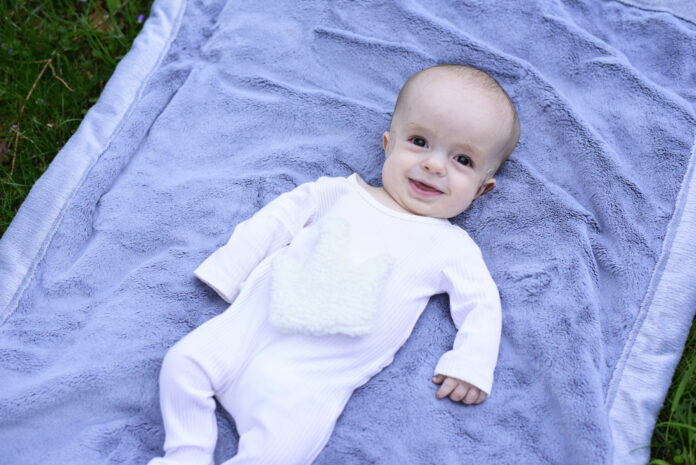When Chavi Sheffield was expecting her fifth child, she found out, at 24 weeks, that his limbs measured below the third percentile. The doctor broke the news gently to Chavi and her husband, Yehoshua: He suspected that their baby had achondroplasia, a form of dwarfism.
At first, Chavi cried. A lot. Her mind raced with worries: a baby with disabilities, a lifetime of challenge. But she worked hard to calm herself. She says, “We couldn’t know for sure or do anything about it until the baby was born. I decided that I wouldn’t do any research. No Googling. What would be the point? There’d be plenty of time for that afterwards, if necessary. Meanwhile, I hoped they’d made a mistake. And I knew that if the doctors hadn’t made a mistake, then Hashem had already given our baby—and us—the strength to face whatever was ahead.”
Yehoshua, who has been described as a perpetual optimist, was ready. “Whatever it is, we’ll accept it. We’ll work it out.”
The Sheffields live in Baltimore, with very few immediate family members living near them. They didn’t share the news with their relatives or friends. They went to a gadol for a brachah. He told them to daven for a healthy baby. Chavi says, “I davened. But I also understood that if a neshamah is meant to come down into this world with this condition, then that’s how he will come. We would love this child, no matter what.”
Their baby boy was born on the second day of Rosh Hashanah, 2020, joining an “all boy” family. The doctors told the Sheffields that the visual signs of achondroplasia were very prominent in their son. They placed him in Chavi’s arms, and she knew right away that they hadn’t made a mistake. “His weight was normal, but his arms and legs were very small. He had an extra cute nose and was delicious. Really. He looked perfect.”
It was Yom Tov. She had no one to call and no way to look up information about achondroplasia. To her, this felt like a brachah. “Hashem just gave us our marching orders for the year. We don’t always get to know what Hashem wants from us. But this was very clear: Our baby would need much more than a typical baby, and we would do everything we could to take care of him.”
After Yom Tov, Chavi began her research. She has a PhD and is a “data geek,” so she knew what to do. She read medical papers and found out that there are different types of dwarfism; achondroplasia is the most common one. She didn’t think she’d ever seen anyone with achondroplasia, until her father reminded her that they knew an orthopedic surgeon who had it. Chavi realized she knew two other doctors—all with short stature and short limbs—who had achondroplasia, as well. She thought: If they can become doctors, then my son can become a rosh yeshivah.
The Sheffields spoke to Rabbi Baruch Rabinowitz over the phone. He shared that when his son was born with Down syndrome, he told his rebbe, Rav Moshe Shapiro, “The doctors think my baby has Down syndrome.”
His rebbe immediately said, “You get a double mazel tov!”
Rabbi Rabinowitz thought that Rav Shapiro didn’t hear what he’d said, so he repeated it.
And his rebbe, too, repeated what he’d said, and added, “What are the odds of his being born to you both at this age? One in 1,200? Is this not hashgachah pratis? Zeh lo nisayon, zeh tafkid—it’s not a nisayon, it’s a mission.”
Chavi took those words to heart, repeating them to herself over and over again. They would carry her through many medical encounters requiring a lot of patience.
She read that achondroplasia comes with risk factors. For example, the foramen magnum, the opening for the spinal cord at the base of the skull, is narrower. Any compression in that area could put pressure on the brain or spinal cord—which meant that activities such as contact sports or jumping on a trampoline could be life-threatening for her son. She also read that her baby needed to lie flat as much as possible.
As they prepared for the bris milah, Yehoshua and Chavi discussed names. Chavi’s grandfather, Yitzchok, had passed away a year earlier. He’d suffered a stroke 30 years before his passing, and, even though he’d been in pain and dealing with many physical challenges, he’d refused to let his difficulties define him and had always exuded simchah. They only realized afterwards that the baby was born on the second day of Rosh Hashanah—the day we read about Akeidas Yitzchak.
At the bris, Yehoshua let their guests know, “Hashem gave us a baby with physical challenges,” and he clarified what they were dealing with. He also repeated the words of Rabbi Rabinowitz and shared that the family accepted this as a tafkid.
Chavi’s family rallied behind them and bought a stroller that allowed Yitzchok to lie flat. They referred to it as his “chariot.”
A few days after Yitzchok’s birth, Chavi brought him to the genetics clinic at Johns Hopkins Hospital for a consultation with a world-wide expert on achondroplasia. A lot of what she heard, she already knew: There was no cure and no treatment. The doctor mentioned a clinical trial for a drug, Vosoritide, to increase the height of children with achondroplasia. Even though the height increase was only a few inches, it could prevent some of the complications such as back pain and stenosis that are aggravated by a patient’s short stature.
Vosoritide had already been studied; it’s been placed on the market for children aged five and up. The clinical trial was to test it for use on children under age five. Chavi asked her good friend, a pediatrician, for advice. Her friend said, “At this point, do the preliminary screening. You’re not committing yet. If they offer him a slot in the trial, then you’ll get daas Torah and make a decision.”
The closest site for the clinical trial was in DuPont Hospital in Delaware—an hour’s drive from the Sheffield’s home in Baltimore. When Chavi called, she was told that they weren’t accepting new patients into the study. The next site was the Vanderbilt Clinical Research Center in Nashville, Tennessee—a two-hour flight away. She called and found out that the trial protocol included at least a dozen trips in a year.
She tried to imagine leaving her family and traveling with her baby 12 times a year. She discussed it with Yehoshua. They concluded, “There are no other treatments, no other options. This is the only thing we can do for him. We have to give him the best chance we can.” With the support of Chai Lifeline volunteers and practical assistance from the Jewish Caring Network, their journey began.





















